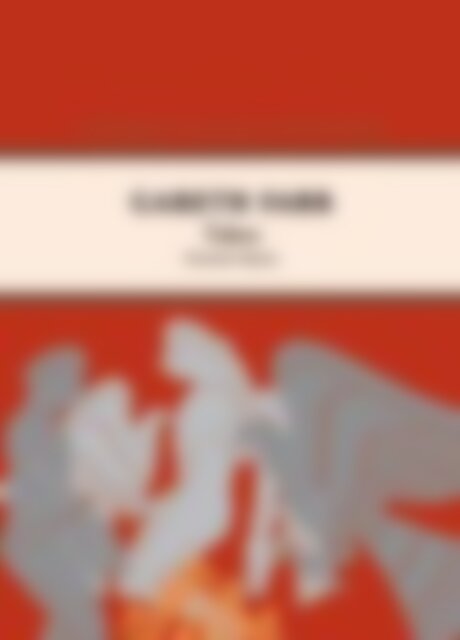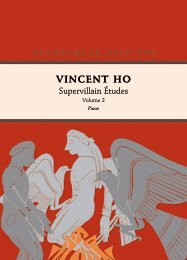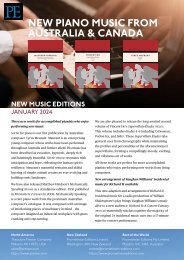Tubes
by Gareth Farr | Percussion Quartet
by Gareth Farr | Percussion Quartet
You also want an ePaper? Increase the reach of your titles
YUMPU automatically turns print PDFs into web optimized ePapers that Google loves.
PROMETHEAN EDITIONS<br />
GARETH FARR<br />
<strong>Tubes</strong><br />
Percussion Quartet
Gareth Farr<br />
<strong>Tubes</strong><br />
Percussion Quartet<br />
PROMETHEAN EDITIONS<br />
WELLINGTON
<strong>Tubes</strong> (PE130) for Percussion Quartet by Gareth Farr (2008)<br />
© Promethean Editions 2008<br />
First edition © 2013 Promethean Editions Limited (201505)<br />
Series Editor: Ross Hendy<br />
Editor: Ben Woods<br />
ISBN: 978-1-877564-30-7 (print)<br />
ISBN: 978-1-77660-130-1 (ebook)<br />
ISMN: 979-0-67452-192-5<br />
Promethean Editions Limited<br />
PO Box 10-143<br />
Wellington<br />
NEW ZEALAND<br />
http://www.promethean-editions.com<br />
No part of this publication may be reproduced in any form or by<br />
any means without permission in writing from the Publisher.<br />
PE130 – ii
Gareth Farr (1968)<br />
Gareth Farr was born in Wellington, New Zealand. He began his studies in composition and<br />
percussion performance at the University of Auckland. The experience of hearing a visiting<br />
gamelan orchestra prompted his return to Wellington to attend Victoria University, where the<br />
characteristic rhythms and textures of the Indonesian gamelan rapidly became hallmarks of<br />
his own composition. Farr continued with postgraduate study in composition and percussion<br />
at the Eastman School of Music in Rochester, NY, where his teachers included Samuel Adler<br />
and Christopher Rouse.<br />
The inclusion of his works in four events at the 1996 New Zealand International Festival of<br />
the Arts inaugurated his career as a dedicated freelance composer. Since then, Farr’s music<br />
has been heard at, or especially commissioned for, high-profile events including the 50th<br />
anniversary of the New Zealand Symphony Orchestra ( From the Depths Sound the Great Sea<br />
Gongs), the opening of the Museum of New Zealand Te Papa Tongarewa ( Te Papa), and the<br />
2000 Olympic Games in Sydney ( Hikoi, a concerto for percussionist Evelyn Glennie and the<br />
NZSO). In 2003, a commission by the Auckland Festival resulted in Stone and Ice, composed<br />
for the combined forces of the NZSO and the Auckland Philharmonia Orchestra. In 2006<br />
Farr was made an Officer of the New Zealand Order of Merit, for his services to music and<br />
entertainment. In the same year, the Royal New Zealand Ballet toured the country with their<br />
brand new work The Wedding, featuring a score by Gareth Farr. At ninety minutes, it was<br />
among the ballet company’s most ambitious projects, and combined Farr’s talents with those<br />
of prominent New Zealand novelist and librettist Witi Ihimaera.<br />
Farr’s music was integral to Maui – One Man Against the Gods, a stage show four years in the<br />
making. First premiered in 2003, it featured aerial theatre, Maori kapa haka, contemporary<br />
dance and song, with Farr’s stirring music, and toured a number of centres in New Zealand.<br />
In more recent years, Farr has developed a fruitful collaboration with director and librettist<br />
Paul Jenden, producing four comedy musicals. In 2007 Farr was appointed as Composer-<br />
PE130 – iii
in-Residence for the Auckland Philharmonia Orchestra. The residency culminated in 2008<br />
with the premiere of Ex Stasis, a symphonic song cycle for four soloists. In 2008, Farr also<br />
celebrated the world premiere of his work Terra Incognita, for bass solo, choir and orchestra,<br />
performed by Paul Whelan and the Orpheus Choir with the New Zealand Symphony<br />
Orchestra. Farr’s artistic excellence was acknowledged when he received the Arts Foundation<br />
of New Zealand’s Arts Laureate Award 2010, which aims to celebrate significant artistic<br />
achievement as well as nurture future creative endeavours.<br />
In March of 2014 Farr’s Concerto for Piano and Orchestra received its world premiere from<br />
soloist Tony Lee and the New Zealand Symphony Orchestra, conducted by Pietari Inkenen.<br />
Its UK premiere followed one year later, with Lee backed by the BBC Philharmonic, with<br />
conductor Tecwyn Evans. The BBC Philharmonic included Farr’s work alongside Douglas<br />
Lilburn’s Symphony No.2 as a programme to mark the 100th anniversary of the ANZAC<br />
troops’ battle at Gallipoli during World War I. The concerto received critical acclaim,<br />
described by the Dominion Post’s John Button as containing “marvellously free piano<br />
writing surrounded by orchestral sounds that conjure up memories of Prokofiev ballets,<br />
Ravel’s L’Enfant et les Sortileges and even the Bartok First Piano Concerto…the ear was tickled<br />
bar after bar. I have no doubt that this marvellously inventive piano concerto is bound to<br />
develop an international life all its own.”<br />
Farr’s music is particularly influenced by his extensive study of percussion, both Western<br />
and non-Western. Rhythmic elements of his compositions can be linked to the complex and<br />
exciting rhythms of Rarotongan log drum ensembles, Balinese gamelan and other percussion<br />
music of the Pacific Rim.<br />
Latest information about the composer may be found at www.garethfarr.com.<br />
PE130 – iv
<strong>Tubes</strong> (2008)<br />
As the antithesis of Farr’s previous works for STRIKE Percussion such as Pukul (PE096) and<br />
Ukare Funk (PE129) which exude machismo through large multi-percussion setups and high<br />
energy playing, <strong>Tubes</strong> restricts each player to one simple instrument producing one pitch.<br />
Farr utilises the interlocking playing techniques of Balinese gamelan music to create the<br />
illusion of one polyphonic instrument from the four performers. The incessant pulse often<br />
found in Farr’s music is constant throughout.<br />
<strong>Tubes</strong> was commissioned for STRIKE Percussion with funding from Creative New Zealand<br />
and received its premiere performance as part of their show Elemental at Downstage Theatre,<br />
Wellington, New Zealand, on 3 July 2008.<br />
Performance notes<br />
Instruments<br />
• The instruments for this work are four hollow aluminium pipes approximately 8–12cm<br />
in diameter. Ideally all four pipes should be the same diameter with the choice based<br />
on what is comfortable for the performers to handle. The pipe material must be thick<br />
enough to be resonant when struck, but not too thick as to be heavy and cumbersome.<br />
The material should be thicker than a drainpipe as to not easily be dented, but thinner<br />
than scaffolding pipe. Each performer has just one pipe and holds it with the palm and<br />
fingers near the centre in their non-dominant hand.<br />
• The lengths of the pipe are to be ordered so that Percussion 1 has the highest pitch<br />
(shortest pipe) and Percussion 4 the lowest sounding pitch (longest pipe). The pipes<br />
should range between 25cm for Percussion 1, and 55cm for Percussion 4, with Percussion<br />
2 and 3 fitting in between at approximately 35cm and 45cm respectively. These<br />
measurements are only a guide and the ensemble should use their judgement when<br />
sourcing the instruments for this work.<br />
PE130 – v
• The pitches produced are not critical and so have not been specified but the ensemble<br />
should work to make each pitch distinct so that the mixture of overtones creates a rich<br />
but pleasant sonority when all four are played simultaneously.<br />
Beater<br />
• The beater used to strike the aluminium tube should ideally be a steel rod with a felt tip.<br />
The rod should be solid steel, similar in diameter to a regular drumstick (~1.5cm) but<br />
slightly shorter at around 30cm in length. A taper is not necessary. At the tip must be<br />
a layer of thick felt to act as the main beater surface. The felt should be approximately<br />
0.3cm thick and extend about 3cm down the shaft.<br />
• If the ensemble cannot source or create a beater as described above, a felt tipped metal<br />
shafted beater—as sometimes used by tenor drum players of a drumline—may be used.<br />
Playing technique<br />
• The hollow aluminium pipe is to be held near the centre in the non-dominant hand and<br />
the beater in the dominant hand. The pipe is ideally held on an angle (not vertical nor<br />
horizontal) so that a quasi-normal sticking action can be used.<br />
• All regular noteheads are to be played with a moderately firm grip on the aluminium<br />
pipe and by striking the pipe with the felt tip of the beater. This should produce a<br />
deadened but semi-pitched<br />
À<br />
tone.<br />
• Noteheads with the (open) symbol are to be played by throwing the pipe a short<br />
distance out of the hand and hitting it with the felt tip of the beater. You will need to<br />
throw the pipe prior to the moment when the note must sound. The distance the pipe<br />
travels from the hand should be minimal, as to minimize the risk of losing control and<br />
dropping the pipe, but far enough to be free in the air when struck to produce a resonant<br />
tone. The time in the air should also be equal to the notated duration before the pipe is<br />
caught again, and therefore damped by the hand.<br />
• ¿ noteheads are to be played by firmly gripping the aluminium pipe and striking with<br />
the metal shaft of the beater. This metal-on-metal sound should be harsh and contrasting<br />
to the regular playing technique for this work.<br />
• In the penultimate measure of work, during the bar rest, the aluminium pipe should be<br />
turned to be horizontal and perpendicular to the players dominant arm and beater. To<br />
play the final measure, throw the pipe in the air—higher than previously—and then hit<br />
upwards at one end of the pipe. Using the correct amount of force, ensure the pipe rotates<br />
180 degrees before catching it again.<br />
PE130 – vi
TUBES<br />
Gareth Farr<br />
Percussion 1<br />
Percussion 2<br />
Percussion 3<br />
Percussion 4<br />
Π= 160<br />
ã 4 8 œ œ œ œ œ œ œ œ 4 6 .<br />
pp<br />
ã 4 8 œ œ œ œ œ œ œ œ 4 6 .<br />
pp<br />
ã 4 8 œ œ œ œ œ œ œ œ 4 6 .<br />
pp<br />
ã 4 8 œ œ œ œ œ œ œ œ 4 6 .<br />
pp<br />
œ À œ À œ œ œ œ<br />
cresc. poco a poco<br />
≈ œ À . Œ œ œ œ œ<br />
J<br />
cresc. poco a poco<br />
‰ J<br />
œ À Œ œ œ œ œ<br />
cresc. poco a poco<br />
‰. œ À Œ œ œ œ œ<br />
R<br />
cresc. poco a poco<br />
4<br />
4<br />
4<br />
4<br />
≈ œ À . Œ œ œ<br />
J<br />
‰ J<br />
œ À Œ œ œ<br />
‰.<br />
œ À Œ œ œ<br />
R<br />
œ À œ À œ œ<br />
4 3 ‰ œ À Œ œ 4 9 J<br />
4 3 ‰. œ À Œ œ<br />
R<br />
4 9<br />
4 3 œ À œ À œ 4 9<br />
4 3 ≈ œ À . Œ œ<br />
J 4 9<br />
5<br />
ã 4 9 ‰. œ À Œ œ œ œ œ œ œ œ .<br />
R<br />
4 9 4 9 4 9<br />
4 5 4 5 4 5 4 5 .<br />
œ À œ À œ œ œ<br />
≈ œ À . Œ œ<br />
J<br />
‰<br />
œ À<br />
J<br />
Œ<br />
4 3 4 3 4 3 4 3 4 2 4 2 4 2 4 2 4 7 4 7 4 7 4 7<br />
ã<br />
œ À œ À œ œ œ œ œ œ œ<br />
.<br />
.<br />
≈ œ À . Œ œ œ œ<br />
J<br />
‰<br />
œ À Œ œ<br />
J<br />
‰.<br />
œ À<br />
R<br />
Œ<br />
ã<br />
≈ œ À . Œ œ œ œ œ œ œ œ<br />
J<br />
.<br />
.<br />
‰<br />
œ À Œ œ œ œ<br />
J<br />
‰.<br />
œ À Œ œ<br />
R<br />
œ À<br />
œ À<br />
ã<br />
‰<br />
œ À Œ œ œ œ œ œ œ œ<br />
J<br />
.<br />
.<br />
‰.<br />
œ À Œ œ œ œ<br />
R<br />
œ À œ À œ<br />
≈ œ À .<br />
J<br />
Œ<br />
9<br />
ã<br />
4<br />
7<br />
‰.<br />
œ À Œ œ œ œ œ œ<br />
R<br />
.<br />
4<br />
.<br />
œ À œ À œ œ<br />
4 3 ≈ œ À . Œ œ 4 2 ‰ œ À Œ 4 5 ‰. œ À Œ œ œ œ<br />
J<br />
J<br />
.<br />
R<br />
4 3 4 2 4 5<br />
4 3 4 2 4 5<br />
4 3 4 2 4 5<br />
4 3 4 3 4 3 4 3<br />
ã<br />
7<br />
4<br />
œ À œ À œ œ œ œ œ<br />
.<br />
4<br />
.<br />
≈ œ À . Œ œ œ<br />
J<br />
‰ J<br />
œ À Œ œ<br />
‰.<br />
œ À<br />
R<br />
Œ<br />
œ À œ À œ œ œ<br />
.<br />
ã<br />
4<br />
7<br />
≈ œ À . Œ œ œ œ œ œ<br />
J<br />
.<br />
4<br />
.<br />
‰ J<br />
œ À Œ œ œ<br />
‰.<br />
œ À Œ œ<br />
R<br />
œ À<br />
œ À<br />
≈ œ À . Œ œ œ œ<br />
J<br />
.<br />
ã<br />
4<br />
7<br />
‰ J<br />
œ À Œ œ œ œ œ œ<br />
.<br />
4<br />
.<br />
‰.<br />
œ À Œ œ œ<br />
R<br />
œ À œ À œ<br />
≈ œ À .<br />
J<br />
Œ<br />
‰ J<br />
œ À Œ œ œ œ<br />
.<br />
14<br />
ã 4 3 . œ À œ À œ<br />
mf<br />
ã 4 3 . ≈ œ À . Œ œ<br />
J<br />
mf<br />
ã 4 3 . ‰ œ À Œ œ J<br />
mf<br />
ã 4 3 . ‰. œ À Œ œ<br />
R<br />
mf<br />
4 2 ≈ œ À . Œ 4 1 ‰ œ À 4 3 ‰ œ À Œ œ<br />
J J J<br />
.<br />
4 2 ‰ œ À Œ 4 1 ‰. œ À 4 3 ‰. œ À Œ œ<br />
J<br />
.<br />
R R<br />
4 2 ‰. œ À Œ 4 1 œ À 4 3 œ À œ À œ .<br />
R<br />
4 2 œ À œ À 4 1 ≈ œ À .<br />
J 4 3 ≈ œ À . Œ œ<br />
J<br />
.<br />
œ À œ À œ<br />
pp cresc.<br />
≈ œ À . Œ œ<br />
J<br />
‰ J<br />
œ À Œ œ<br />
‰.<br />
pp cresc.<br />
pp cresc.<br />
œ À Œ œ<br />
R<br />
pp cresc.<br />
≈ œ À . Œ œ<br />
J<br />
‰ J<br />
œ À Œ œ<br />
‰.<br />
œ À Œ œ<br />
R<br />
œ À œ À œ<br />
‰ J<br />
œ À Œ œ<br />
‰.<br />
œ À Œ œ<br />
R<br />
œ À œ À œ<br />
≈ œ À . Œ œ<br />
J<br />
‰.<br />
œ À Œ œ<br />
R<br />
œ À œ À œ<br />
≈ œ À . Œ œ<br />
J<br />
‰ J<br />
œ À Œ œ<br />
4<br />
4<br />
4<br />
4<br />
<strong>Tubes</strong> © 2008 Promethean Editions Ltd<br />
This Edition © 2013 Promethean Editions Ltd PE130 – 1<br />
ISMN: 979-67452-192-5
22<br />
4<br />
ã<br />
ã<br />
ã<br />
ã<br />
4<br />
4<br />
4<br />
.<br />
.<br />
.<br />
.<br />
Œ ‰ ¿ Œ ¿ J<br />
ff<br />
‰ ¿ Œ ¿ Œ J<br />
ff<br />
Œ ¿ Œ ‰ ¿ J<br />
ff<br />
Ó ‰ ¿.<br />
ff<br />
Œ œ œ œ<br />
mp<br />
Œ œ œ œ<br />
mp<br />
Œ œ œ œ<br />
mp<br />
¿ œ œ œ<br />
mp<br />
4 3 œ À œ À œ 4 ≈ œ À . œ À œ À œ 4 6 ‰ ¿ Œ œ œ œ œ 4 ≈ œ À . œ À ≈ œ À . œ À<br />
J<br />
4 3 J J J<br />
4 3 ≈ œ À . Œ œ<br />
J 4 ‰ œ À ‰. œ À 4 6 ff mp<br />
Œ œ ‰ ¿ Œ œ œ œ œ 4 ‰ œ À ‰. œ À ‰ œ À ‰. œ À 4 3 J R J J R J R<br />
4 3 ‰ œ À Œ œ 4 ‰. œ À ‰ œ À Œ œ 4 6 ff mp<br />
‰ ¿ Œ œ œ œ œ 4 ‰. œ À ‰ œ À ‰. œ À ‰ œ À 4 3 J R J J R J R J<br />
4 3 ‰. œ À Œ œ<br />
R<br />
4 œ À ≈ œ À . Œ œ<br />
J 4 6 ff mp<br />
‰ ¿ Œ œ œ œ œ 4 œ À ≈ œ À . œ À ≈ œ À . 4 3<br />
J J J<br />
ff mp<br />
28<br />
ã 4 3 ‰ ¿ Œ œ 4 ≈ œ À . œ À ≈ œ À . œ À 7 8 ¿ ‰ ¿ Œ. 4 6 œ À œ À œ œ œ œ 8 5 ‰ ¿ ¿ ‰ ¿ 4 J J J<br />
J J J J<br />
ã 4 3 ff<br />
mp<br />
‰ ¿ Œ œ 4 ‰ œ À ‰. œ À ‰ œ À ‰. œ À 7 ff<br />
8 4 6 mp<br />
Œ ≈ ¿.<br />
¿ ‰ ≈ œ À 8 5 ff<br />
. Œ œ œ œ œ ‰ ¿ ‰ ¿ ‰ 4 J J R J R J<br />
J<br />
J J<br />
ã 4 3 ff<br />
mp<br />
‰ ¿ Œ œ 4 ‰. œ À ‰ œ À ‰. œ À ‰ œ À 7 ff<br />
8 4 6 mp<br />
Œ ¿ ‰ ¿ ¿ ‰ œ À 8 5 ff<br />
Œ œ œ œ œ ‰ ¿ ¿ Œ 4 J R J R J<br />
J J J J J<br />
ã 4 3 ff<br />
mp<br />
‰ ¿ Œ œ 4 œ À ≈ œ À . œ À ≈ œ À . 7 ff<br />
mp<br />
8 ‰ ¿ Œ ‰. ¿ ‰ 4 6 ‰. œ À Œ œ œ œ œ 8 5 ff<br />
‰ ¿ Œ ¿ 4 J J J J R R<br />
J J<br />
ff<br />
mp<br />
ff<br />
mp<br />
ff<br />
33<br />
ã<br />
ã<br />
ã<br />
ã<br />
4<br />
4<br />
4<br />
4<br />
≈ œ À . œ À ≈ œ À . œ À<br />
J J<br />
mp<br />
‰ œ À ‰. œ À ‰ œ À ‰.<br />
J R J<br />
mp<br />
‰. œ À ‰ œ À ‰. œ À ‰ œ À<br />
R J R J<br />
œ À mp<br />
≈ œ À . œ À ≈ œ À .<br />
J J<br />
mp<br />
œ À<br />
R<br />
4 3 œ À œ œ 4 ≈ œ À . œ À ≈ œ À . œ À 4 3 ‰ ¿ Œ œ<br />
J J<br />
J<br />
4 3 Œ œ œ 4 ‰ œ À ‰. œ À ‰ œ À ‰. œ À 4 3 ff<br />
mp<br />
‰ ¿ Œ œ<br />
J R J R J<br />
4 3 Œ œ œ 4 ‰. œ À ‰ œ À ‰. œ À ‰ œ À<br />
R J R J 4 3 ff<br />
mp<br />
‰ ¿ Œ œ J<br />
4 3 Œ œ œ 4 œ À ≈ œ À . œ À ≈ œ À .<br />
J J 4 3<br />
ff<br />
mp<br />
‰ ¿ Œ œ J<br />
ff<br />
mp<br />
≈ œ À . œ À ≈ œ À .<br />
J J<br />
‰<br />
‰.<br />
œ À ‰.<br />
J<br />
œ À ‰<br />
R<br />
œ À ≈ œ À .<br />
J<br />
œ À ‰<br />
R<br />
œ À ‰.<br />
J<br />
œ À<br />
œ À<br />
J<br />
œ À<br />
R<br />
38<br />
ã ‰ ¿ Œ œ J<br />
ff<br />
mp<br />
ã ‰ ¿ Œ œ J<br />
ff<br />
mp<br />
ã ‰ ¿ Œ œ J<br />
ff<br />
mp<br />
ã ‰ ¿ Œ œ J<br />
ff<br />
mp<br />
4<br />
4<br />
4<br />
4<br />
≈ œ À . œ À ≈ œ À .<br />
J J<br />
‰<br />
‰.<br />
œ À ‰.<br />
J<br />
œ À ‰<br />
R<br />
œ À ‰<br />
R<br />
œ À ‰.<br />
J<br />
œ À<br />
œ À ‰.<br />
J<br />
œ À ‰<br />
R<br />
œ À ≈ œ À . œ À ≈ .<br />
J J<br />
≈ œ À . œ À ≈ œ À . ‰ ¿<br />
J J J<br />
œ À ‰ œ À ‰. œ À ‰ œ À ff<br />
‰ ¿<br />
R J R<br />
œ À ‰. œ À ‰ œ À ‰. œ À ff<br />
‰ ¿<br />
J R J R J<br />
œ À œ À ≈ œ À . œ À ff<br />
‰ ¿<br />
J J<br />
ff<br />
≈ œ À . œ À ≈ œ À . œ À<br />
J J<br />
mp<br />
‰ œ À ‰. œ À ‰ œ À ‰. œ À<br />
J R J R<br />
mp<br />
‰. œ À ‰ œ À ‰. œ À ‰ œ À<br />
R J R J<br />
œ À mp<br />
≈ œ À . œ À ≈ œ À .<br />
J J<br />
mp<br />
≈ œ À . œ À ‰ ¿ ‰ ¿<br />
J<br />
‰ œ À ‰. œ À ff<br />
‰ ¿ ‰ ¿<br />
J R<br />
‰. œ À ‰ œ À ff<br />
‰ ¿ ‰ ¿<br />
R J<br />
ff<br />
œ À ≈ œ À . ‰ ¿ ‰ ¿<br />
J<br />
ff<br />
PE130 – 2
43<br />
ã ≈ œ À . œ À ≈ œ À . œ À<br />
J J<br />
mp<br />
ã ‰ œ À ‰. œ À ‰ œ À ‰. œ À<br />
J R J R<br />
mp<br />
ã ‰. œ À ‰ œ À ‰. œ À ‰ œ À<br />
R J R J<br />
ã œ À mp<br />
≈ œ À . œ À ≈ œ À .<br />
J J<br />
mp<br />
≈ œ À . œ À ≈ œ À . ‰<br />
J J<br />
‰<br />
‰.<br />
œ À ‰.<br />
J<br />
œ À ‰<br />
R<br />
¿<br />
J<br />
ff<br />
œ À ‰ œ À ‰ ¿<br />
R<br />
œ À ‰. œ À ff<br />
‰ ¿<br />
J R J<br />
ff<br />
¿<br />
J<br />
ff<br />
œ À ≈ œ À . œ À ‰<br />
J<br />
≈ œ À . œ À ≈ œ À . œ À<br />
J J<br />
mp<br />
‰ œ À ‰. œ À ‰ œ À ‰. œ À<br />
J R J R<br />
mp<br />
‰. œ À ‰ œ À ‰. œ À ‰ œ À<br />
R J R J<br />
œ À mp<br />
≈ œ À . œ À ≈ œ À .<br />
J J<br />
mp<br />
rit. (2nd time only)<br />
‰ ¿ ¿ ¿ ¿ ¿ ¿ ¿<br />
‰ ¿ ¿ ¿ ¿ ¿ ¿ ¿ .<br />
‰ ¿ ¿ ¿ ¿ ¿ ¿ ¿ .<br />
‰ ¿ ¿ ¿ ¿ ¿ ¿ ¿ .<br />
.<br />
47<br />
ã<br />
ã<br />
ã<br />
ã<br />
Π= 120<br />
. Œ ¿ œ Œ<br />
mp<br />
¿<br />
. œ<br />
mp<br />
¿ œ ¿<br />
. ‰ œ Œ Œ œ œ J<br />
mp<br />
. Œ œ Œ ≈ œ.<br />
J<br />
mp<br />
‰ œœ¿ œ À œ À œ À<br />
À À À<br />
3<br />
Œ œ œ œ œ<br />
Œ ‰ J<br />
œ Œ ¿<br />
Œ ¿ Œ ¿<br />
3<br />
Œ ¿ œ ¿<br />
‰ J<br />
œ ¿ ‰ J<br />
œ œ<br />
Œ œ ‰.<br />
Œ ‰ J<br />
œ À Œ ¿<br />
œ‰ œ<br />
R J<br />
Œ ¿ Œ ¿<br />
Œ ¿ œ œ Œ ¿<br />
Œ œ œ ‰ œ À œ À œ À<br />
À À À<br />
3<br />
‰ œ œ Œ œ œ œ<br />
3<br />
Œ ¿ Œ ¿<br />
‰ œ œ À ‰ œ À œ œ À<br />
Œ ‰ œ Ó J<br />
Œ ¿ Œ ¿<br />
À À<br />
Œ ¿ Œ ¿<br />
‰ œ<br />
J œ œÀ œ<br />
œ Œ ‰ œ Œ J<br />
Œ ¿ Œ ¿<br />
53<br />
ã œ ¿ Œ œ œ<br />
œ À œ À œ À Œ ¿<br />
. œ œ ≈ œ œ ‰ œ œ ¿<br />
Œ ¿ Œ ¿ œ œ<br />
Œ ¿ œ ‰ J<br />
œ<br />
ã<br />
ã<br />
ã<br />
‰ œ ¿ œ ≈ œ.<br />
J J<br />
Œ œ ‰ J<br />
œ ¿<br />
Œ ‰ J<br />
œ Œ ¿<br />
3<br />
œ À œ À œ À Œ ¿<br />
3<br />
œ À œ À œ À Œ ¿<br />
3<br />
œ À œ À œ À Œ ¿<br />
3<br />
. œ œ ≈ œ œ Œ œ œ ‰<br />
Œ ¿ Œ ‰ œ œ<br />
Œ ¿ Œ ¿<br />
À Œ ¿ Œ œ œ ‰<br />
‰. œ ≈ œ.<br />
R J<br />
‰ œ œ Œ<br />
œ.<br />
œ ≈ œ.<br />
J<br />
œ œ ‰ ¿<br />
‰ œ ‰ œ ‰ œ À ‰ J<br />
œ<br />
Œ œ Œ<br />
3<br />
3<br />
œ À<br />
J<br />
‰ J<br />
œ<br />
Œ ¿ Œ œ œ<br />
58<br />
ã ≈ œ.<br />
≈ œ.<br />
Œ ¿<br />
J J<br />
ã<br />
‰ œ ‰ œ Œ ¿<br />
∑<br />
Ó Œ œ<br />
Œ œ œ œ œ ‰ J<br />
¿<br />
œ œ œ ‰ œ œ Œ ‰ J<br />
¿<br />
3<br />
‰ J<br />
œ À ‰ Œ ‰ J<br />
œ À ‰ œ À œ œ<br />
3 3<br />
‰ ‰ J<br />
œ À Œ œ À ‰ œ À ‰ œ œ<br />
‰ œ À ‰ œ À ‰ œ À ‰ œ À ‰ J J<br />
.<br />
À À À À<br />
3<br />
Œ œ œ œ ‰ œ<br />
.<br />
ã<br />
ã<br />
‰.<br />
œ ‰.<br />
R<br />
œ Œ ¿<br />
R<br />
Œ œ œ ¿<br />
Œ œ œ œ œ ‰ J<br />
¿<br />
œ œ œ ‰ J<br />
¿ Ó<br />
3<br />
3 3<br />
Ó Œ ‰ ¿ J<br />
Ó Œ ‰ ¿ J<br />
3 3<br />
Œ œ À ‰ œ À Œ œ À œ œ<br />
3<br />
Œ ‰ J<br />
œ À ‰ Œ œ À œ œ<br />
‰ œ À ‰ œ À ‰ œ À ‰ œ À ‰ J J<br />
.<br />
À À À À<br />
3<br />
Œ œ œ œ ‰ œ<br />
3<br />
.<br />
3<br />
3<br />
3<br />
PE130 – 3
63<br />
ã<br />
ã<br />
ã<br />
ã<br />
.<br />
.<br />
.<br />
.<br />
œ À œ À œ À œ À<br />
∑<br />
œ À œ À œ À œ À<br />
∑<br />
‰ œ œ À J À À<br />
∑<br />
J œ œÀ J œ<br />
‰ œ<br />
J œ œÀ œ œ ∑<br />
‰ œ<br />
J œ œÀ œ œ ∑<br />
∑ ‰ œ œ J J œ œÀ J œ<br />
À À À À<br />
À À<br />
‰ œ œ œ œ œ ∑<br />
∑<br />
‰ œ œ œ œ œ<br />
œ œ œ<br />
∑<br />
œ œ<br />
∑ œ œ œ œ œ<br />
∑<br />
‰ œ œ œ œ œ À J J œ<br />
∑<br />
‰ œ œ œ œ œ À J J œ<br />
69<br />
ã œ À œ œ À œ œ œ À<br />
ã<br />
ã<br />
ã<br />
3<br />
∑<br />
œ À œ œ À œ œ œ À<br />
3<br />
∑<br />
‰ œ œ œ À œ œ œ À œ À œ À œ À œ œ À<br />
‰ œ œ œ À œ œ œ À<br />
3<br />
∑<br />
‰ œ œ œ À œ œ œ À œ À œ À œ À œ œ À<br />
‰ œ œ œ À œ œ œ À 3<br />
∑<br />
∑<br />
‰ œ ‰ œ Œ ‰ œ À ‰ J<br />
∑<br />
Œ œ œ œ À ‰ œ À<br />
3<br />
À À œ œ Œ œ œ ‰<br />
∑<br />
œ œ ‰ œ œ ‰ œ œ<br />
∑<br />
Œ œ œ ‰ œ œ œ œ<br />
3<br />
‰ œ œ Œ œ œ œ œ<br />
3<br />
Œ. œ œ Œ œ<br />
œ œ ‰ Œ œ œ œ œ<br />
.<br />
.<br />
.<br />
.<br />
3<br />
3<br />
accel. poco a poco<br />
75<br />
ã œ œ œ À œ œ œ œ œ<br />
cresc. poco a poco<br />
ã œ œ œ œ œ œ œ œ<br />
cresc. poco a poco<br />
ã œ œ œ œ œ œ À œ œ<br />
cresc. poco a poco<br />
ã œ œ œ œ œ œ œ œ<br />
œ œ œ œ œ œ œ À œ<br />
œ œ À œ œ œ œ œ œ<br />
œ œ œ œ œ œ œ œ<br />
œ œ œ œ À œ œ œ œ<br />
œ œ œ œ œ œ œ œ<br />
œ œ œ À œ œ œ œ œ<br />
œ œ œ œ œ œ œ œ<br />
œ œ œ œ œ œ œ À œ<br />
œ œ À œ œ œ œ œ À œ<br />
œ œ œ À œ œ œ œ À œ<br />
œ œ œ œ À œ œ œ À œ<br />
œ œ œ œ œ À œ œ À œ<br />
œ œ œ œ œ À œ œ œ œ œ œ œ œ œ œ À œ<br />
œ œ À œ œ œ œ œ À œ œ œ À œ œ œ œ œ œ<br />
œ œ œ À œ œ œ À œ œ œ œ œ À œ œ œ œ œ<br />
œ œ œ œ À œ œ œ œ À œ œ œ œ œ œ À œ œ<br />
cresc. poco a poco<br />
81<br />
ã œ œ œ œ œ À œ œ œ œ À œ œ œ À œ œ œ À œ<br />
ã œ œ À œ œ œ œ œ À œ œ œ œ œ À œ œ œ À œ<br />
ã œ œ œ À œ œ œ À œ œ œ œ œ œ À œ œ œ À œ<br />
ã œ œ œ œ À œ œ œ œ À œ œ œ œ À œ œ œ À œ<br />
œ œ À œ œ œ œ œ œ<br />
œ œ œ À œ œ œ œ À œ<br />
œ œ œ œ À œ œ œ œ<br />
œ œ œ œ œ œ œ À œ<br />
œ œ œ œ œ œ œ À œ<br />
œ œ œ œ À œ œ œ œ<br />
œ œ œ À œ œ œ œ À œ<br />
œ œ À œ œ œ œ œ œ<br />
œ œ œ œ œ œ œ À œ<br />
œ œ À œ œ À œ œ œ œ<br />
œ œ À œ œ À œ œ œ œ<br />
œ œ œ œ œ œ œ À œ<br />
œ œ œ œ œ œ œ À œ<br />
œ œ À œ œ À œ œ œ œ<br />
œ œ À œ œ À œ œ œ œ<br />
œ œ œ œ œ œ œ À œ<br />
87<br />
ã œ œ œ œ œ œ œ À œ<br />
ã œ œ œ œ À œ œ œ œ<br />
ã œ œ œ À œ œ œ œ À œ<br />
ã œ œ À œ œ œ œ œ œ<br />
œ œ À œ œ œ œ œ œ<br />
œ œ œ À œ œ œ œ À œ<br />
œ œ œ œ À œ œ œ œ<br />
œ œ œ œ œ œ œ À œ<br />
œ œ À œ œ À œ œ œ À œ<br />
œ œ œ œ œ œ œ œ<br />
œ œ œ œ œ œ œ œ<br />
œ œ À œ œ À œ œ œ À œ<br />
œ œ À œ œ À œ œ À œ œ À<br />
œ À œ œ À œ œ À œ œ À f<br />
œ<br />
œ œ À œ œ À œ œ À f<br />
œ œ À<br />
œ À œ œ À œ œ À œ œ À f<br />
œ<br />
f<br />
(prepare pipe)<br />
∑<br />
(prepare pipe)<br />
∑<br />
(prepare pipe)<br />
∑<br />
(prepare pipe)<br />
∑<br />
Ó Œ œ À^<br />
Ó œ À^ Œ<br />
Œ œ À^ Ó<br />
œ À^ Œ Ó<br />
PE130 – 4
PROMETHEAN EDITIONS


















